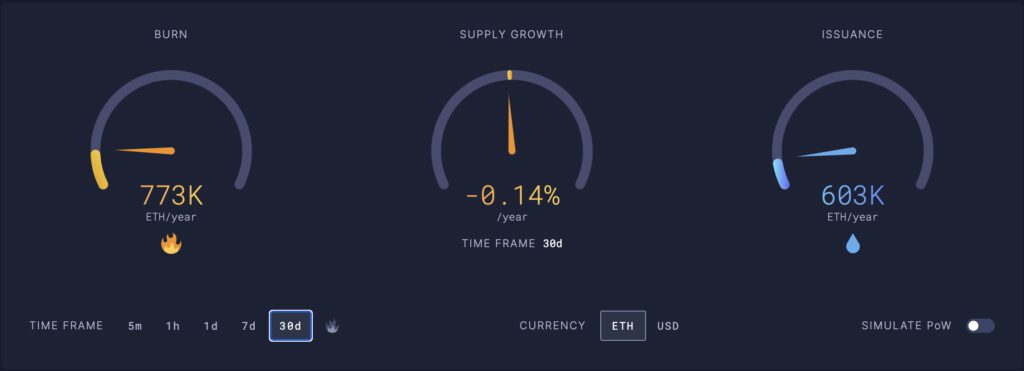The annual supply rate of Ether (ETH) slipped below zero for the first time since Ethereum’s transition to proof-of-stake via the Merge in September. The reason? A spike in on-chain activity amid a massive cryptocurrency market crash.
Ether turns deflationary for real
As of Nov. 9, more Ether tokens are being burned than created as a part of Ethereum’s fee-burning mechanism. Simply put, the more on-chain transactions, the more ETH transaction fees get burned.
On a 30-day timeframe, the Ethereum network has been burning ETH at an annual rate of 773,000 tokens against the issuance of 603,000 tokens. In other words, ETH’s supply is going down by 0.14% per year.
Overall, the Ethereum network has burned 2.72 million ETH since the fee-burning mechanism was introduced in August 2021. That amounts to the permanent destruction of nearly 4 ETH per minute.
Ethereum’s transaction fees spiked to their highest levels since May 2022 due to traders rushing to transfer their ETH to and from exchanges amid the dramatic collapse of FTX.

In detail, nearly 1 million ETH has left exchanges in November, according to data from Glassnode.

Many analysts see Ether’s deflationary prospects as a bullish signal, which should boost its overall scarcity. But the ongoing deflationary rate is a product of current ETH price volatility, which may hurt its recovery prospects in the near term.
Ether’s price in danger of another 50% crash
Ether’s price dropped nearly 20% month-to-date and was trading around $1,250 on Nov. 11 after it had rebounded from its $1,075 local low.
Furthermore, Ether’s price action has also entered the breakdown stage of its prevailing symmetrical triangle pattern, which may push the price down further by another 50% from current levels.
Related: Bitcoin price hits multi-year low at $15.6K, analysts expect further downside
Symmetrical triangles are continuation patterns, meaning they typically resolve after the price breaks out of their range while pursuing the direction of its previous trend. As a rule of technical analysis, the pattern’s profit target is measured after adding the triangle’s height to the breakout point.

Applying the theory to Ether’s symmetrical triangle places its downside target at around $675 by December 2022, down about 50% from current prices.
It got rejected from 1600-1650. Now it’s looking bullish on ltf, so expecting a last leg up to 1700, matching with BTC going to 21000-21500.
1700 is a key resistance. It should get rejected hard.
Main target for a local bottom = $700-800 pic.twitter.com/UkAphVl2MV
— il Capo Of Crypto (@CryptoCapo_) November 2, 2022
More bearish arguments stem from a recent decline in the supply held by Ethereum’s richest investors.
Notably, the duration of Ether’s November downtrend has coincided with the drop in Ether supply held by addresses with a balance between 1 million ETH and 10 million ETH.

Conversely, addresses with a balance between 1,000 ETH and 10,000 ETH have risen during its price decline.
This could mean two things. First, addresses with over 1,000,000 ETH tokens reduced their holdings and thus landed in the 1,000-10,000 ETH cohort.

Second, the 1,000-10,000 ETH cohort saw the Ether price decline as a “buy the dip” opportunity, which boosted its control over the Ethereum supply in November.
The views and opinions expressed here are solely those of the author and do not necessarily reflect the views of Cointelegraph.com. Every investment and trading move involves risk, you should conduct your own research when making a decision.


